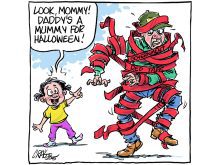Today there are five new red dots on the map of Saskatchewan hanging in my office.
They represent five more stops in my progress as president of the Saskat-chewan Weekly Newspapers Association.
Last week, in two days, I visited the papers at Gull Lake, Shaunavon, Assiniboia, Gravelbourg and Herbert. The visits are informative. Traveling the province is even more so.
The trip from Shaunavon to Assiniboia, for instance, took much longer than expected because of highway conditions.
Everywhere we went, people said they had the worst roads in Saskatchewan. They are all right.
Read Also

Farmer ownership cannot be seen as a guarantee for success
It’s a powerful movement when people band together to form co-ops and credit unions, but member ownership is no guarantee of success.
When Berny Wiens from Herschel was elected to the legislature a few years ago, one of his first pronouncements was that some secondary highways would be turned back to gravel. That suggestion didn’t go over well in the country and was shelved until last week when, unlike our highways, it resurfaced.
At the same time, government member Pat Lorje said rural Saskatchewan highways have less traffic than does the alley behind her home.
Pat must have some alley.
Our highways are used by grain trucks, by farmers in their half-tons and cars going to and from town, by people going to the country and to the city, by people heading for the golf course and the regional park and the ferry, by the ambulance, by school buses and fire trucks and police, by trucks bringing goods to town.
I doubt that Pat’s alley is so well used.
Her words were not only unfeeling but they reflect the disdain with which the government treats rural Saskatchewan.
Turning highways back to gravel is bad enough, but it now appears such roads will also be turned over to municipalities. Added tax money will not follow.
It’s called downloading, and a careful reading of the tomes of information on amalgamation shows downloading is its goal. Health reform was about money. So is amalgamation.
It is past time for the province to come up with a comprehensive development plan for rural Saskatchewan.
There was a glimmer of hope that this would happen in the speech from the throne earlier this year, but that initiative appears to have died.
It should be revived. Rural people should be involved; rural people not necessarily being rural politicians.
At present, things are guided by folks in Regina who don’t live in the country or drive on country roads.
That isn’t the way to run a province that is mostly rural and in which distance between communities is a fact of daily life.














